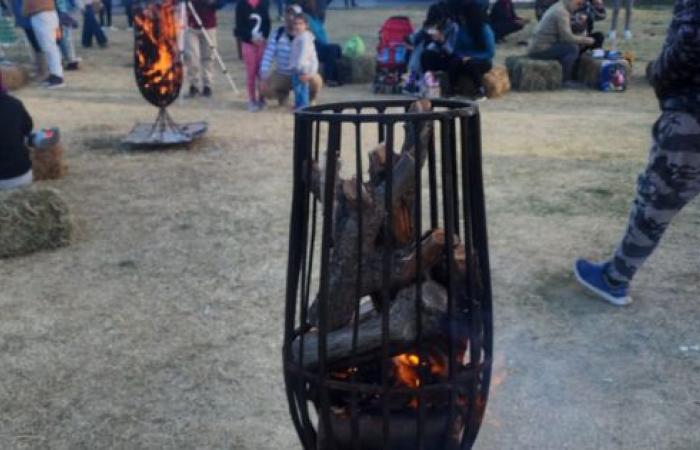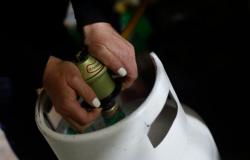“This is an action of war, for lovers of fire and earth”show businessman Alejandro Aruj said metaphorically, while observing a group of tourists from La Plata, tasting marinated meats and Cuyan humitas, with good Bonarda, in the I Veraison Festivalheld last weekend in the department of San Martín.
Thousands of people attended this original celebration, despite the cold and the general atmosphere of economic and social crisis that afflicts our country. In this gray context, visitors lived a brilliant day, summoned by the warmth of the stoves, in an exciting and majestic setting.
Huddled around crackling logs that served as an outdoor stove (Figure 1) and sitting on bales of grass, which evoke the rural Argentina of heroic times (Figure 2), visitors had the opportunity to experience a weekend full of emotion, with high-quality identity gastronomy, folk music by local artists and an imposing setting, given by the Bóvedas museum, former home of the Liberator José de San Martín.
Figure 2. Visitors and tourists sit on bales of grass. Veraison Festival. Courtesy of Marcelo Ronchetti.
“Walking through this place, where two hundred years ago the Liberator walked with his officers and friends, represents a unique experience, full of meaning”, explained Jorge Corrales, the director of Tourism of San Martín, and the main architect of this festival, together with Emetur, the Undersecretary of Culture of Mendoza, the Institute of Rural Development (IDR) and the Olivíçola Association of Mendoza (Asolmen). Indeed, in that property you can still capture the vibration of the lost steps of José de San Martín with Manuel de Olazábal, Juan Gregorio de Las Heras, Mariano Necochea, José Félix Aldao and many more (Figure 3). Heroic times, set then, as now, with Creole music and dance: gato, pericón, chacarera and malambo. These details were taken care of by the artistic curatorship of the festival (music and dance), led by the director of Culture of San Martín, Alfredo Lafferiere.
Who are the protagonists of the Mendoza Este Olive Tree Festival?
“We valued everything we have in the East as a genuine, authentic product of ours; it was a Creole patio, people came to enjoy it from all over the province“he added. “It is the starting point of a series of activities that we are going to multiply for the entire province, the country and abroad.”
Figure 3. Las Bóvedas Museum, backdrop of the I Veraison Festival, held in the patio of the former house of José de San Martín. Courtesy: Alejandro Aruj.
The olive oil tastings were a ring of hope for attendees (Figure 4). There they were able to discover the incredible advances made by the producers of Mendoza who, in recent years, managed, for the first time in five centuries, to displace the producing superpower, Spain, from the first world awards, and bring the awards to the Cuyo capital.
From the land to the table: sustainable gastronomy
These victories in blind olive oil tastings, with 14 international juries, represent the bloodless renewal of the battles of Chacabuco and Maipú, with renewed actors; as officers and troops, this time they form the olive growers of Rivadavia, Junín, San Martín and the challenge of the province of Mendoza; and as general in chief, the brilliant Gabriel Guardia, our senior olive grower. These oils, awarded worldwide, allowed the coordination that gave rise to this First Provincial Veraison Festival.
Figure 4. Olive oil tastings at the I Provincial Veraison Festival. Courtesy Mariano Morales.
The olive oil tasting took place in a high-level environment, surrounded by the territory’s wines (particularly Bonarda), and the emerging regional identity gastronomy, exclusively with dishes that included olive oil, and cooked over direct heat, such as in the pre-industrial era, in the times of San Martín, Rosas and the vitimigrants of 1884. Thus, the great gastronomes of Mendoza Este stood out.
“1883”, an essential series for Mendoza people with a black palate
“This festival has taught us many things, among them that together we are more. One for all and all for one”Daniel Aguilera, director of Tourism of Rivadavia, exclaimed happily, proud of the presentation of wines, oils and gastronomy of his department. “I was with friends of life, old and new, who are couples; Rivadavienses united with Juninense, Sanmartinians and Santarrocinos, Paceños and Rivadavienses, all mixed by some ancestral design, with children who have both blood and roots; we are one, We are Mendoza Este.” Bartolomé Robles, a wine and olive oil producer from Rivadavia, shared similar words.
Junín was not left behind because it also had its gastrocultural ambassadors. “Sandra Agüero, from “Chocoletras” and Hernán Torres from “Torrecitos” participated, sweets, jams and artisanal chocolate; and especially, the “cydonia bonbon”, based on quince paste with walnuts, macerated in virgin olive oil ( EVOO) and dipped in 70% cocoa Ecuadorian chocolate,” said Junín Tourism Director, Jonathan Peralta, proudly.
The leaders of the territory were happy and full of pride. “It’s a matter of starting, putting it in first gear and not stopping, everything is possible,” boasted the writer Marcela Muñoz Pan. “This Festival should be included in the tourist circuits,” she added. “The greatest credit went to Corrales for bringing in local producers, MSMEs from the East, who were very successful,” Lafferiere acknowledged. “
“People are enthusiastic about participating in events where they feel like they are the protagonists; everyone tasting, talking, dancing”said architect Ana Martínez (Plan Bonarda).
Yellowstone, the Netflix series: where are our cowboys?
The magic of the event was given by the regulations; The industrial modality of the food truck with its junk food was not accepted: on the contrary, only direct-heat meals were accepted, as in the heroic times of San Martín, Rosas and the vitimigrants of 1884. This presented a challenge for the chefs. guests, but, it helped create an atmosphere of identity and Argentineness. What could you eat?
“Roast tapa marinated in olive oil, with spices; ground Tucumán chili, salt flavored with garlic and onion”said heritage chef Marcelo Ronchetti. He also offered “humita from Mendoza on the flame, in a pot, but with embers-fired squash (on embers), to give it creaminess, with corn kernels and olive oil with basil, to give it a touch of freshness”.
When tasting these specialties, some began to notice that Ronchetti is not a chef of the industrial chain, but a cultural ambassador of his territory, who has taken the trouble to complete a Master in heritage cuisine and now projects Junín and all of Mendoza Este through its original preparations.
The congratulations did not stop, even from the academic and former general director of Schools, Emma Cunietti, a cultural reference in the East of Mendoza. “Value our land, our water, our air, our fires. It’s what makes us different”he noted.
Mendoza Este, a place to relive experiences of the migrant pioneers of 1884
Why is it an action of war? we asked Aruj. “For the productive chains between local SMEs, true protagonists of this celebration; for the careful artistic curation of music and dance; because the products of the territory were promoted; this is done from the bottom up; the axis is not in the big brands, but in the territory”explained the businessman. “In addition, the prices were very affordable, which, added to the authenticity of this proposal, without makeup, and the attitude of productive links with the territory, marks a clear difference with the elitist and enclave events that other destinations promote.”
“The cultural dimension is the element in which this tourist activity of highlighting local products was developed. In that sense, a new dimension opens up: just as the wine industry has opted for classical music and tango To develop the paths of wine, olive oil is established from here, as an ally of national folk music, that of San Martín and Rosas. Hence the artistic grid that was developed in this festival, with works by Mercedes Sosa. and Daniel Talquenca; Jorge Marciali, Juan Draghi Lucero and Félix Dardo Palorma; The Cuyan songbook!explained economist Mariano Morales. “This is a true orange economy experience.” “Culture and identity are the water that keeps the rhizome alive,” Aruj added.
In this Veraison festival, the heartbeat of the territory could be felt. The setting was the patio of Don José de San Martín’s house. From this base, a different tourist destination is being built, from the bottom up, in a rhizomatic way.






